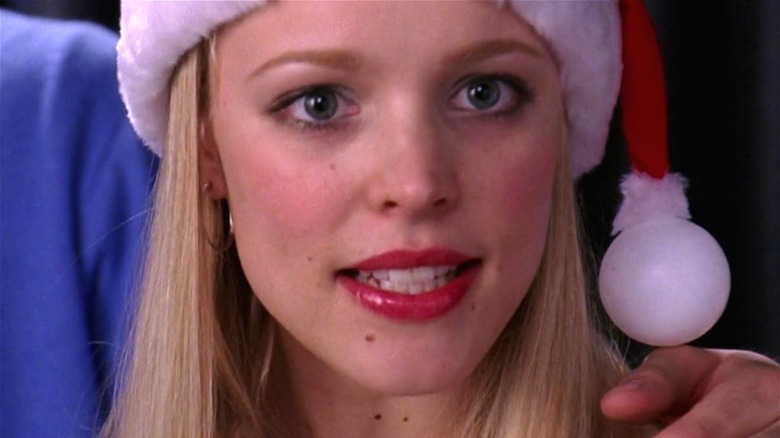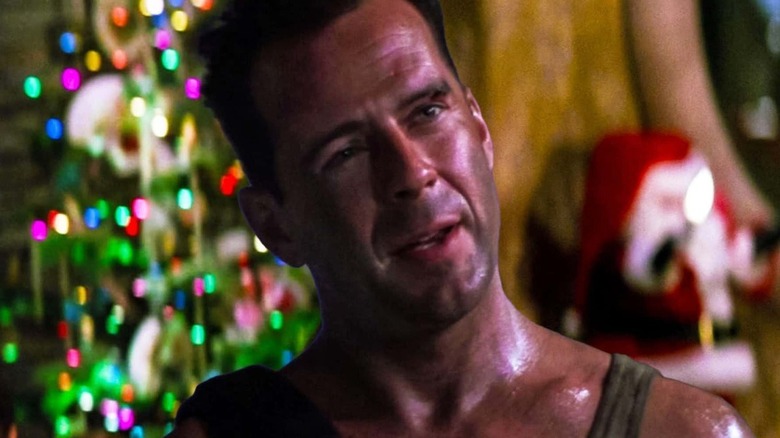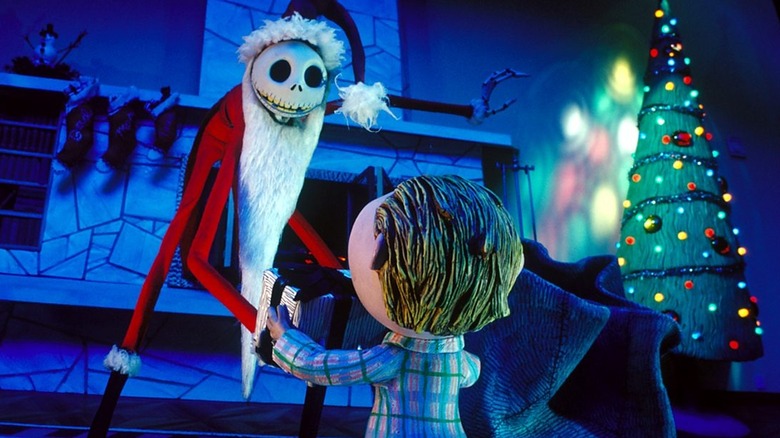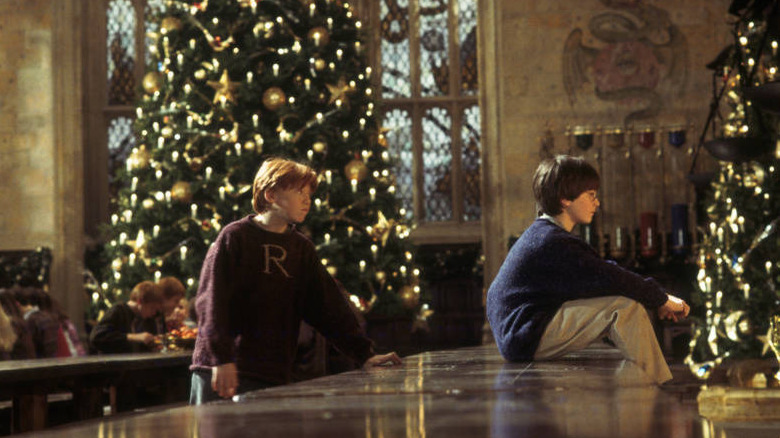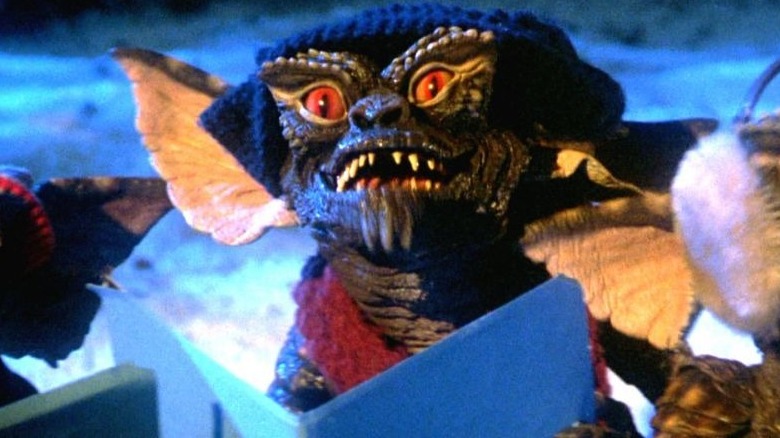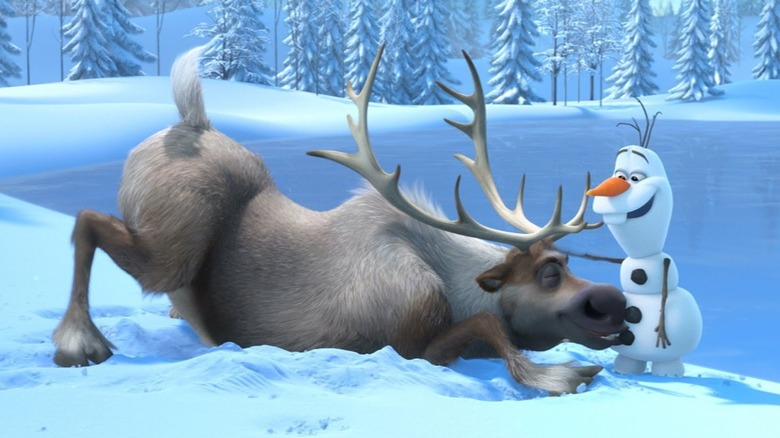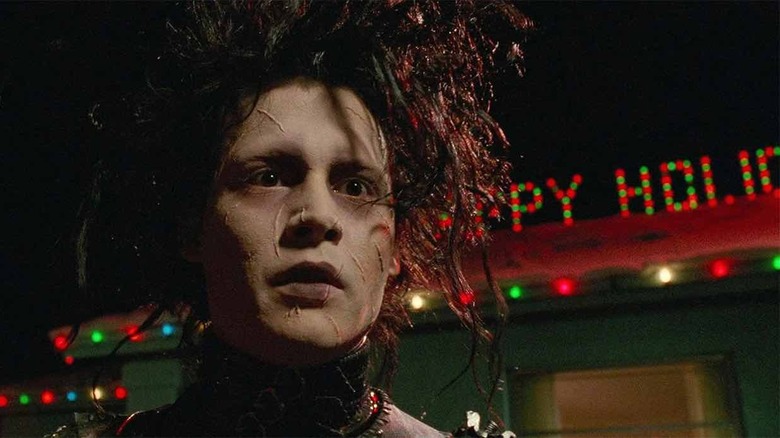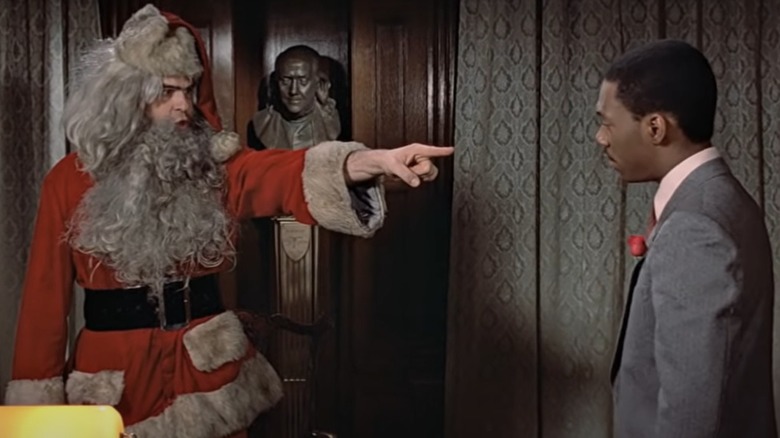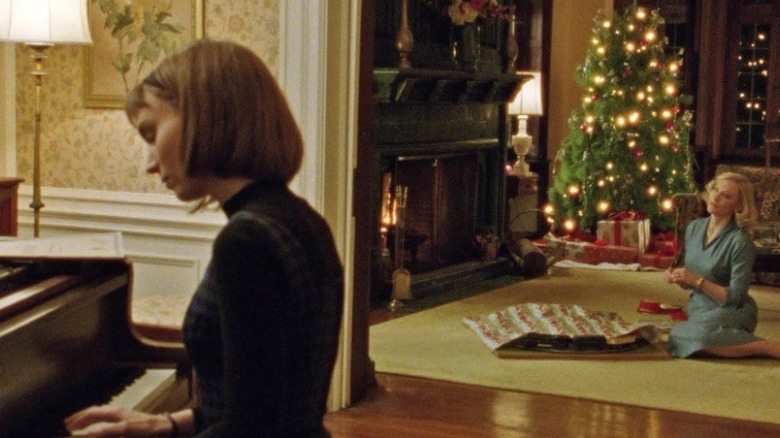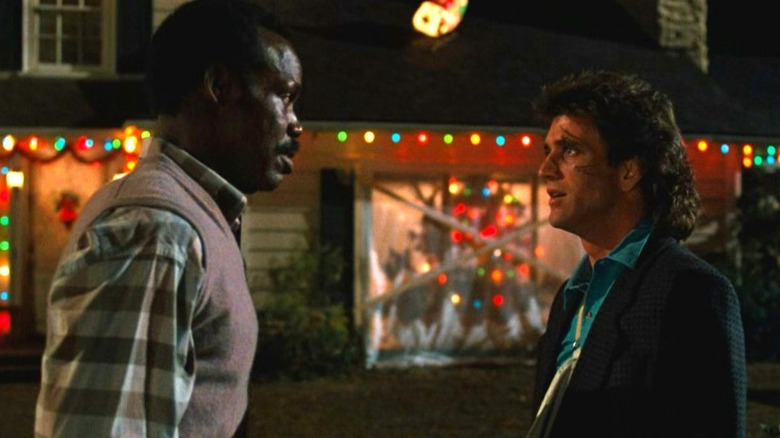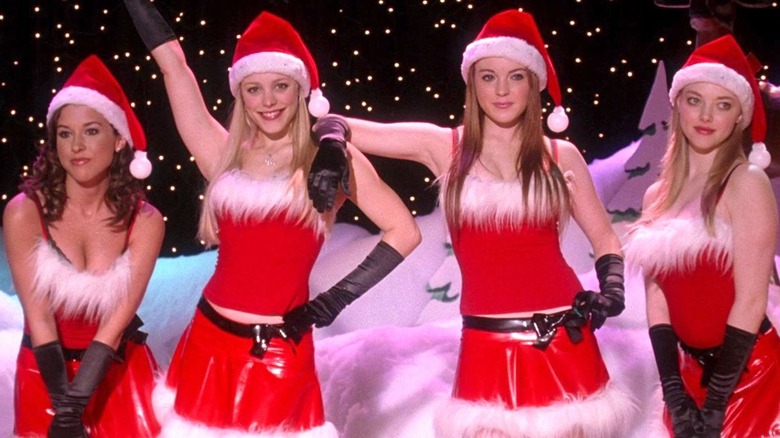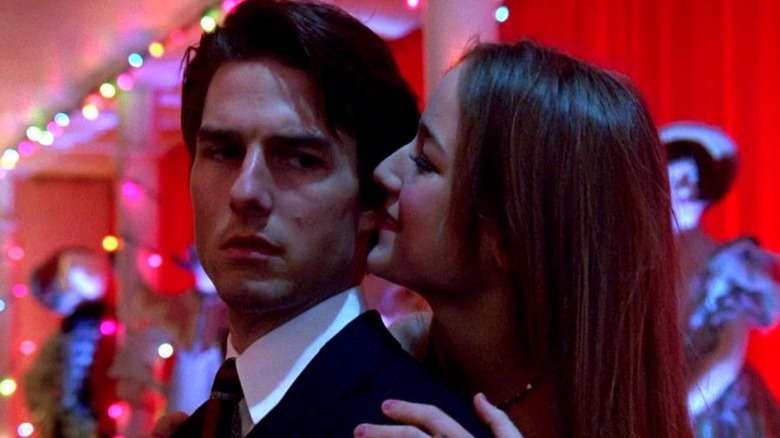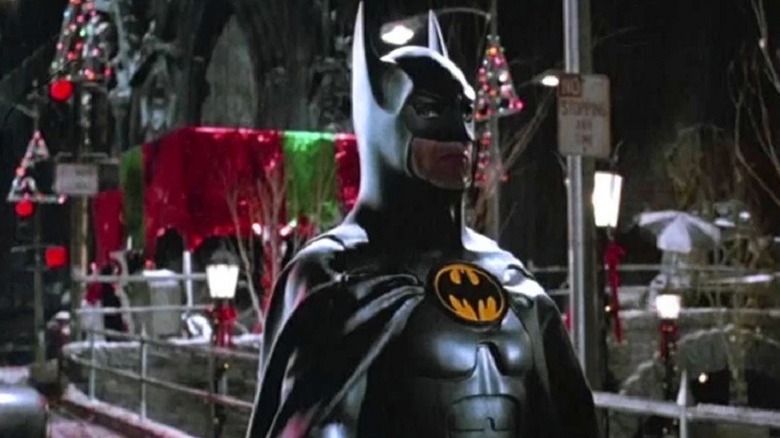12 Movies That People Can't Agree On Being Christmas Movies
There are certain elements that indisputably make a film a Christmas movie. In addition to largely taking place during the holidays, Christmas movies usually place Christmas morning as either the ending or at least the climax of the film, as that's the scene where lessons are learned and conflicts are resolved. Many Christmas movies heavily feature Santa Claus – either the idea of him or a literal representation of him – with the children's characters believing in him and the adults doubting him. Beyond that, there is usually wall-to-wall Christmas music throughout the film, featuring either old standbys, new entries from current artists, or a mixture of the two.
That said, there are some movies that definitely have Christmas elements or are otherwise Christmas-adjacent but don't check off enough boxes for them to be universally accepted into the pantheon of Christmas films. As sure as people will forever debate ham versus turkey for the family Christmas feast or if real trees are superior to artificial ones, there is an annual argument as to whether certain moves should or shouldn't count as Christmas movies. Some have long been at the forefront of such debates, while others aren't as widely discussed and thus still don't have a consensus.
However, this list will include entries at both ends of that spectrum — plus some that fall somewhere in between — as we take a look at films that people can't agree on whether or not they qualify as Christmas movies.
Die Hard
The movie that more or less started the idea of even debating the Christmas-ness of certain films, the events of "Die Hard" are centered around an office Christmas party and has the Run-DMC classic "Christmas in Hollis" ringing out before the opening credits have finished rolling. Things don't end there, as the holiday is referenced multiple times throughout the movie, from John McClane (Bruce Willis) leaving a "ho-ho-ho" message on the shirt of a villain he gunned down to Hans Gruber (Alan Rickman) encouraging his hacker ally by reminding him "It's Christmas, Theo. It's the time of miracles."
The interesting thing about doubting "Die Hard" as a Christmas movie is that almost nobody doubts that "Home Alone" is one, and people have often pointed out how similar those two films are. In fact, Cracked did an entire article about how "Die Hard" and "Home Alone" are basically the same movie. Also, "Die Hard" came first, which makes "Home Alone" the imitator, and if "Home Alone" is an undeniable Christmas movie, then the movie that inspired it must also be one by default — even if the total tally of swear words and dead bodies is a bit higher.
As for Willis himself, Insider reports that he finally weighed in on the age-old debate during his 2018 Comedy Central Roast, stating, "Die Hard is not a Christmas movie! It's a g****mn Bruce Willis movie!" Fair enough, Bruno. Fair enough.
The Nightmare Before Christmas
It might seem like a no-brainer to consider "The Nightmare Before Christmas" a Christmas movie given that the name of the December holiday is right there in the title. However, what makes things more complicated when it comes to Tim Burton and Henry Selick's stop-motion classic is that Halloween also features very heavily in the movie. After all, the movie's opening scene and musical number feature a song called "This is Halloween" — which has helped it land on lists that are all about that particular holiday.
However, there are just as many songs from Danny Elfman's incredible soundtrack for "Nightmare Before Christmas" that can be added to your Christmas playlist as your Halloween one. In fact, "What's This?" is one of the best new Christmas songs of the last 30 years.
What it all comes down to is whether a movie can be both a Halloween movie and a Christmas movie – and honestly, why couldn't it? On the Christmas side of things, the film has a Santa Claus character that comes from what is seemingly an entire dimension dedicated to preparing for and celebrating that holiday. That it also acknowledges and spends some time in Halloween Town shouldn't exclude its consideration as a Christmas movie. Ultimately it's both, and that's a big part of what makes it so special.
Harry Potter and the Sorcerer's Stone
Some have made the case that the entire "Harry Potter" movie franchise is fitting for Christmas, with almost every installment having at least one pivotal or fan-favorite scene where the holiday is front and center. Still, it's with the first film, "Harry Potter and the Sorcerer's Stone," that this precedent is not only established but is the most prominent. If you're reading this right now and have images in your head of Hogwarts's Great Hall lined with beautifully-decorated Christmas trees, you're likely picturing how it looked in the franchise's first installment.
As it was the first movie, things are still fairly low-stakes here, and everything feels much cozier and family-friendly. It's likely not a coincidence that it was directed by Chris Columbus, who has several bona fide Christmas movies under his belt as either a writer, director, or both by way of "Home Alone," "Home Alone 2: Lost in New York," "Christmas with the Kranks," and "The Christmas Chronicles 2."
Beyond Columbus bringing his eye for holiday filmmaking to the "Harry Potter" universe, it's important to note the festive — and a few plot critical — moments. These include Harry receiving his oh-so-important invisibility cloak as a Christmas present, the caroling ghosts, Hagrid dragging a full-sized tree across the grounds, and the fact that Harry confesses he has his first-ever Christmas dinner during his first year at Hogwarts.
Gremlins
"Harry Potter and the Sorcerer's Stone" isn't the only debatable Christmas movie that Chris Columbus worked on. The second movie he ever wrote was none other than "Gremlins," one of the earliest movies to defy the typical conventions of holiday movies but still do enough to warrant consideration as a holiday movie. Sure, Christmas-themed horror movies date back to at least the early-1970s (per The Hollywood Reporter), but "Gremlins" straddles that line more than most entries in that hybrid genre in that it still dips its toes into being a warm family holiday film rather than being wall-to-wall scary and never pretending to be otherwise.
Things kick off with Billy (Zach Galligan) receiving a mysterious creature known as a mogwai as a Christmas present from his quirky inventor father (Hoyt Axton). It seems like a recipe for a feel-good Christmas story until literally every rule about caring for a mogwai is broken and the sweet, furry pet spawns a mini army of the titular beasts. What follows is Billy's family, friends, and neighbors being tormented by the creatures in ways that push the boundaries of the G rating to the point that the movie helped lead to the creation of PG-13.
Still, it's very much Christmastime in Kingston Falls, the setting of the movie. Further, there is a constant juxtaposition between a gremlin physically and psychologically tormenting its victim while red and green lights blink all around, with classic Christmas standards playing in the background.
Frozen
So is every movie that takes place in mostly snowy locales automatically a Christmas movie? By that logic, you'd have to include movies like "The Thing," "The Revenant," "The Hateful Eight," and "Spies Like Us" in consideration for potential holiday films. However, "Frozen" gets brought into the Christmas movie debate for more reasons than its mostly snow and ice-covered backdrops – though they definitely play a part in making the movie feel appropriate for holiday viewing.
Disney seemed to position "Frozen" as a holiday movie when the company released it in late 2013, meaning that the initial rush of moviegoers saw it during the Christmas season. In addition, two of the main characters are a talking snowman and a reindeer, both typically associated with Christmas. Beyond that, the fact that Olaf (Josh Gad) and Sven made such a perfect duo that they led an actual Christmas-focused "Frozen" short called "Olaf's Frozen Adventure" in 2017 further proves how much they feel like holiday characters.
As for the original movie, The Kingston Whig Standard wrote an entire piece decrying how often "Frozen" is left out of Christmas movie debates. That outlet wrote that the film belongs in that conversation because it has (in addition to what we already mentioned) "winter-related magic ... an iconic song that mentions snow, a fireplace scene, and dysfunctional siblings who show their love in the end."
Edward Scissorhands
Tim Burton seems to love that sweet spot where Halloween and Christmas overlap, even though "Edward Scissorhands" doesn't address that Venn diagram quite as clearly as "The Nightmare Before Christmas" does. Marking the director's first time working with eventual longtime muse and collaborator Johnny Depp, the movie's climatic scenes clearly take place during Christmas, while Halloween isn't directly addressed.
However, in this case, that trademark Burton spookiness and the way it juxtaposes with the wholesomeness of Christmas comes by way of Edward himself. There is his tuft of Robert Smith hair, his pale and scarred skin, his leather, buckle-heavy outfit, and of course, having deadly weapons for hands sticking out like a sore thumb within the movie's generic, idyllic suburbia.
In fact, that suburbia had never seen snow before, not even in the Christmas season. That is, right up until Edward begins carving ice sculptures that cause flecks of snow to cascade out over the neighborhood as if to be a blizzard. An older version of Winona Ryder's character explains in the movie's final scene that she believes that any time it has snowed in the town since Edward left, it has been his doing, sending snow down to blanket the town from his lonely mansion at the top of the hill. What character could be more Christmas-y than one who literally makes the snow that falls on Christmas morning?
Trading Places
One of the most iconic images from the classic John Landis comedy "Trading Spaces" is star Dan Aykroyd looking the worse for wear as a down-on-his-luck Santa in an extremely filthy costume. That checks off a pretty major box on most people's agreed-upon Christmas movie checklist right there. There's also the matter of it taking place entirely within the Christmas season, with an office Christmas party providing the backdrop for several pivotal scenes.
There's more than just Aykroyd's bad Santa and things taking place during the holidays that make "Trading Spaces" a Christmas classic. In a 2015 retrospective, The Atlantic suggested that Christmas is a time of year when the divide between the wealthy and the poor is especially prevalent and that the movie attacks that theme head-on making it a less traditional but perhaps more culturally and socially relevant Christmas movie than most.
Beyond that, Empire Online went so far as to include it in the top five of their list of the 30 best Christmas movies, saying it's "a nice change from some films' ultra-happy Christmases."
Carol
A more recent entry into the debatable Christmas movie pantheon is 2015's period drama "Carol." In this case, it's probably not so much that anyone would debate how Christmas-themed the movie is — rather, any skepticism would likely just come from people who simply haven't heard of it yet. The movie stars Cate Blanchett and Rooney Mara as Carol and Therese, respectively, who start a relationship together in the much less progressive 1950s and therefore have to face the struggles that come with how their romance is judged – none of which is helped by the fact that Carol is still married when their affair begins.
There is no shortage of movies about love and relationships set in and around the holiday season that are universally deemed Christmas movies, so there's no reason "Carol" should get any pushback in that regard. The A.V. Club even goes so far as to proclaim it the best Christmas movie, as it "captures the joy and the melancholy of the holiday season."
We don't know if we'd put it at number one, but it certainly deserves to be included in all future discussions of which movies best represent the emotional highs and lows of Christmas. In that respect, "Carol" is hard to beat.
Lethal Weapon
Screenwriter (and eventual director) Shane Black has a tradition of setting his movies during Christmas, and that can perhaps be best seen in his debut, "Lethal Weapon." Several of Black's movies could've been on this list, from "The Long Kiss Goodnight" to "Kiss Kiss Bang Bang" to his superhero debut "Iron Man 3." Still, besides not wanting him to monopolize the list, "Lethal Weapon" is where the holidays are most deeply interwoven into the fabric of the film rather than just being set during Christmas because it's become Black's thing.
In 2019, film critic Richard Roeper of the Chicago Sun-Times suggested that the debate about "Die Hard" had grown tiresome and that we all should be talking about "Lethal Weapon" instead, as it is "the real Christmas action movie." Roeper points out that the movie opens with "Jingle Bell Rock," frequently shows the Murtaugh (Danny Glover) household fully decked out in Christmas décor, has Riggs (Mel Gibson) first show off his policing skills via a Christmas tree lot drug sting, and showcases the officers at the station practicing their rendition of "Silent Night."
Other than having Santa mysteriously deliver presents on Christmas night, there isn't much left for "Lethal Weapon" to do to prove itself a bona fide Christmas movie. Whether it's a better movie than "Die Hard" is up for debate, but there's no arguing that "Lethal Weapon" isn't far more overtly Christmas-focused.
Mean Girls
True, "Mean Girls" covers the entirety of a school year, and its back-to-school focus also makes it a perfect autumn movie. Still, there are few scenes more enduring than the too-risqué-for-high-school dance number that Cady (Lindsay Lohan), Regina (Rachel McAdams), Gretchen (Lacey Chabert), and Karen (Amanda Seyfried) perform for the school's Christmas pageant. Not only is it just a standout scene for obvious reasons, but it ends up being a major turning point in the dynamic of the foursome and in how Gretchen's feelings for Regina begin to fracture significantly.
It not only doesn't take much searching to find support for the stance that "Mean Girls" is a legit Christmas movie, but The Face goes so far as to proclaim it the greatest Christmas movie ever. The feature points out that the film has more iconic moments that take place during the Christmas portion than you might realize, including the hilarious "You go, Glen Coco!" line delivered by a Santa suit-clad Daniel (Damian Leigh). The article further asserts that "Mean Girls" has many hallmarks of a great holiday movie, from its positive messages about friendship and loyalty to its heavy doses of nostalgia that help give it a timeless feel.
Eyes Wide Shut
Now we get to the put the kids to bed portion of our Christmas movie feature. In fact, "Eyes Wide Shut," director Stanley Kubrick's final completed film, had to be digitally censored in post-production to even get it down to an R rating (per The New York Times). It's pretty wild to think that we very nearly had an NC-17 Christmas movie, but as it stands, we have an R-rated one that largely takes place during a secret sex party on Christmas Eve.
Tom Cruise and Nicole Kidman, still married at the time, star as the also-married William and Alice Harford, who descend into a world where the elite wear masks and do unspeakable things to each other behind velvet curtains and under the glow of Christmas lights. In fact, Kubrick specifically changed the movie to take place during Christmas despite the novella it was based on being set during Mardi Gras. Since Kubrick died before the film was released, he wasn't able to explain the reason for the change himself – but Reverse Shot theorizes that Kubrick made "Eyes Wide Shut" a Christmas film because the holiday is seen as a "simultaneously rejuvenating and culminating" event. Meanwhile, Harper's Magazine points out that "desire is like Christmas: it always promises more than it delivers."
Ultimately, leaving us with a Christmas movie about an orgy before his passing was the most Stanley Kubrick gift Stanley Kubrick could've possibly left us.
Batman Returns
For a filmmaker who is so interested in the gothic and the macabre, Tim Burton has ended up putting multiple would-be Christmas movies into the world. Over a decade before Shane Black turned "Iron Man 3" into the closest thing the MCU had to a Christmas movie prior to "The Guardians of the Galaxy Holiday Special," Burton first combined the holiday and comic book cinema with his second superhero film, "Batman Returns."
Besides just taking place in a snow-covered Gotham during the winter months, Christmas features heavily in the plot of "Batman Returns." Crucially, it figures into Bruce Wayne (Michael Keaton) and Selina Kyle (Michelle Pfeiffer) discovering each other's alter egos as Batman and Catwoman after they share a déjà vu moment under some mistletoe that reminds them of a previous encounter they had as their costume-clad counterparts. Beyond that, there are very few scenes that go by without some Christmas decor being seen in the frame, and the colors of red and green are just as prominent as the typical blacks and greys of a Batman film.
Finally, as pointed out by Screen Rant, the plot of "Batman Returns" recalls various other Christmas tales, from "A Christmas Carol" to "How the Grinch Stole Christmas," and even alludes to the biblical story of the birth of Jesus Christ.
